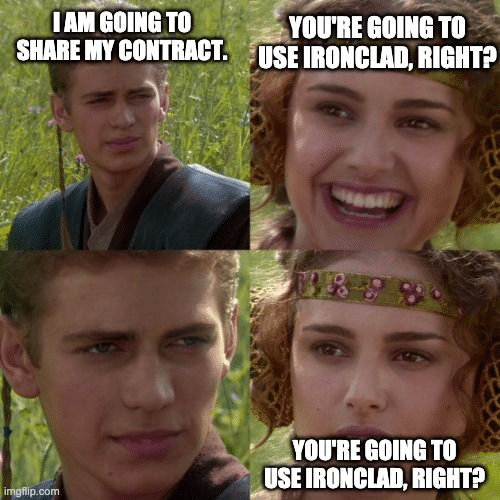Contract Masters is a series featuring the world’s best contract workflows and the innovative people who designed them using Ironclad’s Workflow Designer. Today, we’re excited to introduce you to the creator of the world’s first universal NDA, Ken Carter, General Counsel at Bitmovin, a company that provides adaptive streaming infrastructure for video publishers and integrators.
Meet Contract Master Ken Carter
Ken Carter isn’t just a modern-day GC—He’s more like a GC visiting from the future. With both a JD and an MBA under his belt and 20+ years of domestic and international experience in high-tech enterprises, cybersecurity telecommunications, software, and digital media law and policy, he’s definitely seen his fair share of contracts.
Named General Counsel of the Year in 2016, Ken joined Bitmovin in 2018. Previously, he was Counsel and Head of Legal, Public Policy, and Trust and Safety at Cloudflare, Inc., and the Public Policy and Government Affairs Counsel at Google.
One of Ken’s many contributions to the legal and contract community is the creation of the first universal Non-Disclosure Agreement (NDA). In this article, Ken walks us through the process of creating this contract in Ironclad’s Workflow Designer and the efficiencies it creates for Bitmovin.
Bitmovin’s contracting problem
Bitmovin’s target market is OTT (Over the Top Television) providers, which are companies that have a large catalog of video content that they want to distribute online.
Because their main goal is to help distributors save money by reducing the cost of ownership, Bitmovin’s priority is to shorten the sales cycle and close deals as soon as possible, enabling customers to start saving right away.
Going back-and-forth with a customer over the terms of an NDA or other contract, puts the transaction at risk for both parties and acts as a barrier to the product delivery and customer’s savings.
As the company continued to grow, so did their contract volume, and manually reviewing each contract wasn’t an easily scalable process for their lean legal team. As Ken looked for a better solution, he started to notice that, while the language of the NDAs he was reviewing varied, the meaning still remained the same. He’d been through hundreds of NDAs, but had only come across a few throughout his entire career that he couldn’t sign.
My attitude changed dramatically, from like, ‘Let me negotiate every single deal,’ to ‘Can I engineer myself out of a job? Can I build a system that is so efficient that I don’t even have to come into the office?
NDA contracts
Non-Disclosure agreements are those that create a “confidential relationship” between two people or businesses that involves sensitive information. Their job is to protect information, and they are widely used at the beginning of a business relationship and may be executed in conjunction with many other types of contracts, like sales agreements or HR contracts.
Confronting the risk of automation
Lawyers are extremely risk averse, so automating processes can come with much hesitancy. The key, Ken shares, is to rationalize the loss aversion when it comes to growing your business quickly, and understanding exactly where a loss may fall.
He says that there are two points in which loss can occur: Before a transaction, or after it. Sales teams are focused on the former, and they’re afraid they won’t close a deal due to stubborn legal terms and too many contract revisions. On the other hand, legal teams are more afraid of the latter, which happens when they agree to a bad deal that comes back to bite them later.
After outlining the possibilities, Ken started asking questions like, “What are we going to optimize between these two options?,” and, “Can we change the efficiency frontier?”.
He was so excited about the results that he even created and shared this meme on LinkedIn:
Creating the first universal NDA
Once he decided to optimize the pre-transaction part of the process, Ken easily identified NDAs as part of his job that could become more efficient. “Most NDAs say the same thing, with the exception of a few clauses,” Ken said. “I was struck by the thought of, what if we could model this on the creative commons approach?”
Creative commons is a series of licenses that basically take 400 years of copyright laws and boil them down to seven essential licenses.
Ken brought this problem of standardizing the NDA to interns at UC Hastings law school, and after they read hundreds of NDAs and interviewed 25 GCs, they came up with the first draft of the universal NDA.
Together, they worked with this draft to create the current standard-yet-flexible version of an NDA that includes 13 clauses that each have between one and three permutations. Overall, 192 different versions can be created from the standard NDA, accounting for 99% of instances this contract would be needed, Ken said.
Using Workflow Designer to implement the UNDA
After the terms of the universal NDA had been standardized, it was also time to standardize Bitmovin’s contracting process by using Ironclad’s Workflow Designer.
Creating a workflow
Rather than distributing 192 versions of the NDA or leaving it up to each individual user to decide which type they need, Workflow Designer allows Ken to create a series of self-service multiple choice questions that guide the business user through the process of generating a contract.
For example, the first question is about the business purpose for the contract, and the answers provided determine the conditionality within the agreement.
Negotiation
Next, the questions revolve around alignment, like Do you agree to this definition of a business purpose?, essentially allowing negotiation with a counterparty through the form, rather than involving legal counsel. If a counterparty wants something unique within the contract, the sales rep can handle that within the form, rather than going directly to Ken.
If the counterparty answers “Yes” to these questions, signaling alignment of mutual wants, the agreement is automatically sent for signature. If not, it goes out for additional review. Either way, it serves as a filtering system that gives Ken back time to focus on what’s most important. He also has the flexibility to jump into the form and collaborate internally or with counterparties at any time.
Chatbot
Ken took things a step further to create a Slack chatbot to assist sales reps with the contracts in Ironclad. Rather than fielding questions about which form to use in a specific scenario, he created a similar question-asking bot to ask things like, What’s the status of the customer? or Are we selling our services?, and it automatically generates a link to the correct form in Ironclad.
Bitmovin’s results
In the first six months of using the UNDA, Bitmovin has launched over 100 workflows using this contract, most of which use the preferred standard version that doesn’t require any changes. This is the version Bitmovin and their investors used to fundraise for their Series C.
“NDAs are not quite a weekly thing for me anymore. Previously, I saw them daily, or multiple times daily. It really reduces my workload. And for things that we—that I—don’t want to do,” Ken said of the automated UNDA’s success.
Conclusion
As you can see, Bitmovin’s lean legal team was able to save time on contract review and negotiation by standardizing the terms of an NDA and automating it through a self-service user experience with Ironclad’s Workflow Designer.
“It’s so automated that I don’t worry about it,” Ken added. “If we can build a network based on a universal NDAs, a standard, what else could we use that approach for?”
Ironclad is not a law firm, and this post does not constitute or contain legal advice. To evaluate the accuracy, sufficiency, or reliability of the ideas and guidance reflected here, or the applicability of these materials to your business, you should consult with a licensed attorney. Use of and access to any of the resources contained within Ironclad’s site do not create an attorney-client relationship between the user and Ironclad.
- Meet Contract Master Ken Carter
- Bitmovin’s contracting problem
- NDA contracts
- Confronting the risk of automation
- Creating the first universal NDA
- Using Workflow Designer to implement the UNDA
- Bitmovin’s results
- Conclusion
Want more content like this? Sign up for our monthly newsletter.





